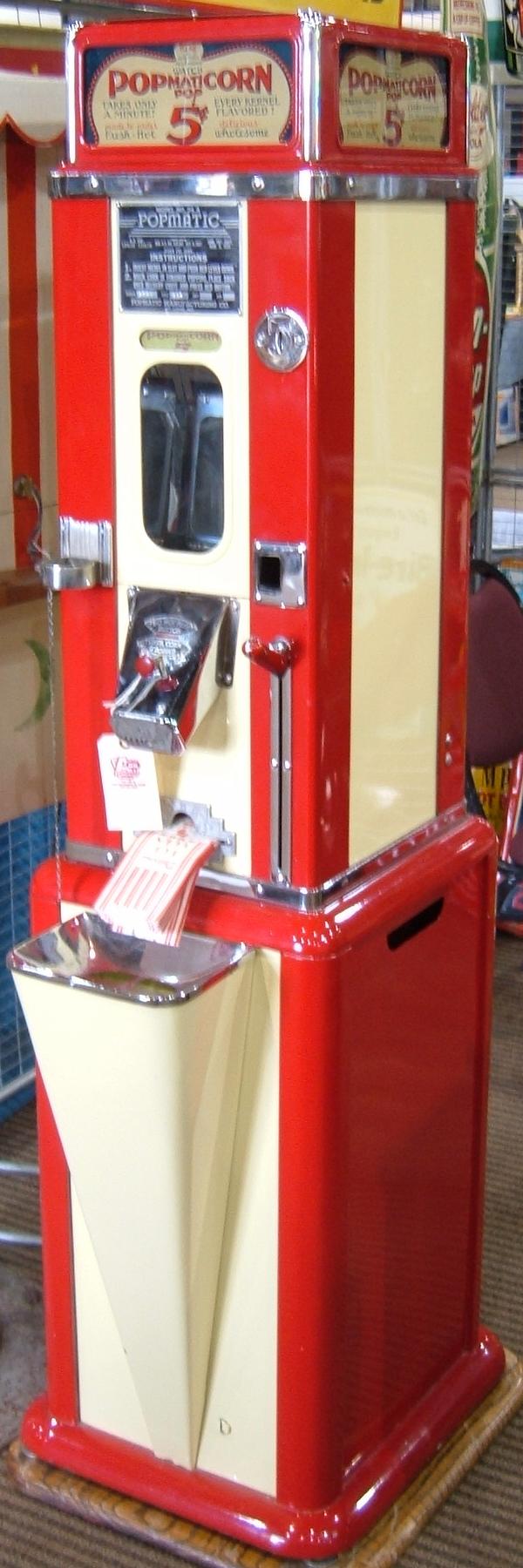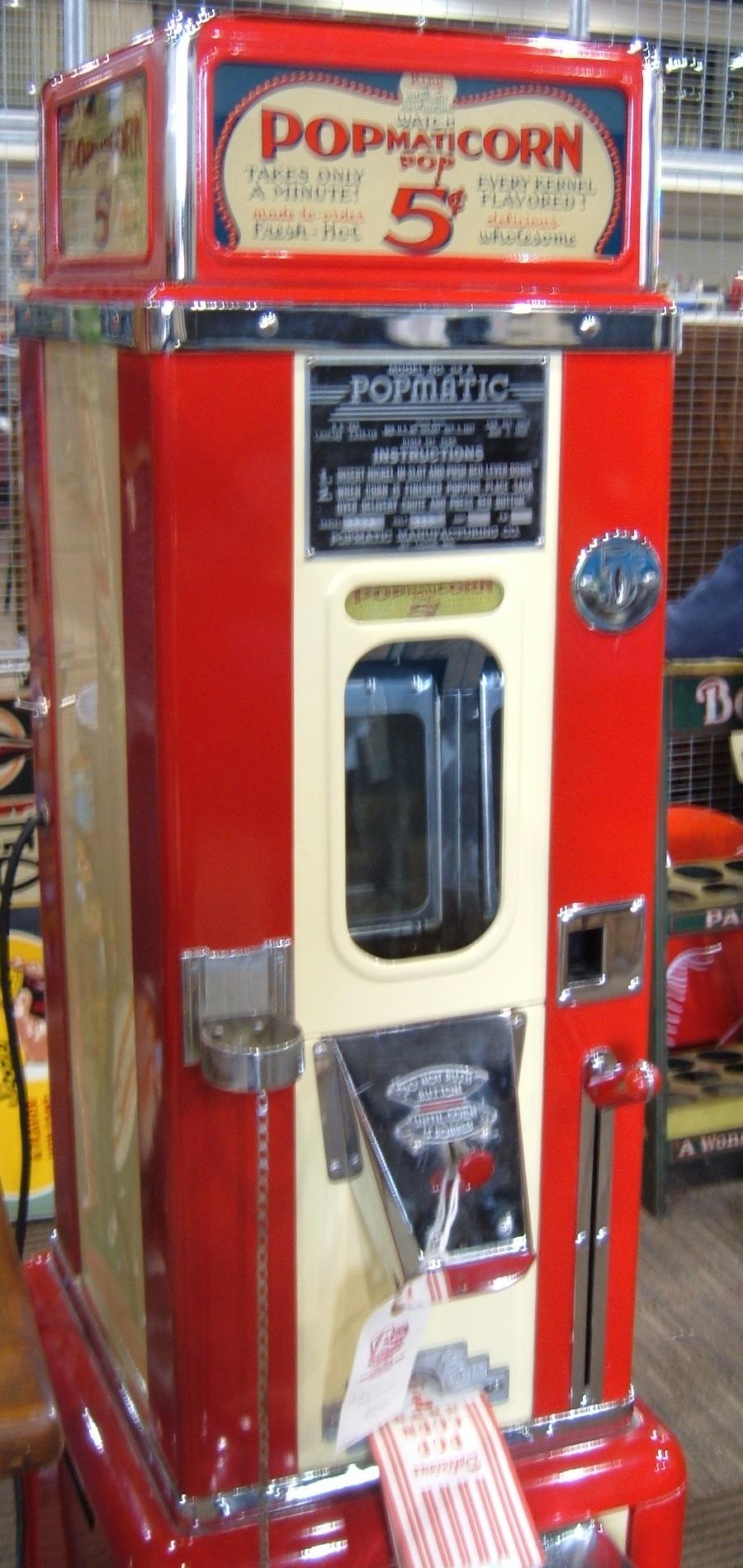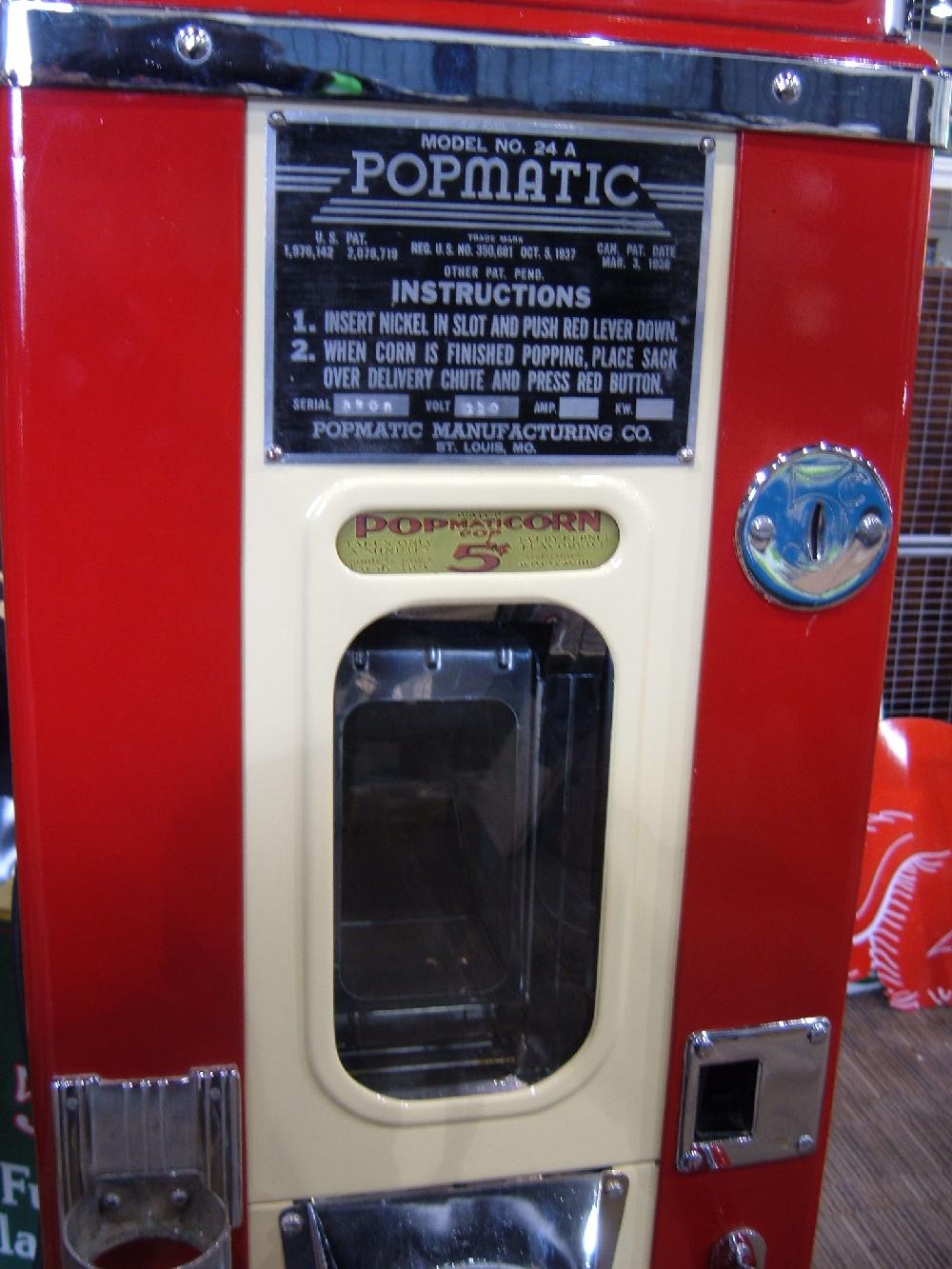1950s U-POP-IT
1950s THE POPCORN SHOP
1950s POPmatiCORN
1960s POP-O-MATIC
Description: 1948 MINIT POP, 1950s U-POP-IT, 1950s THE POPCORN SHOP, 1950s PopMatiCorn, Early 1960s POP-O-MATIC. These coin operated popcorn machines from the mid 1940s to the mid 1950s provide not only great entertainment while popping an individual portion of popcorn, but fantastic, movie-theatre-quality tasting popcorn in just 1 minute. More info on other pop corn machines can be found here.
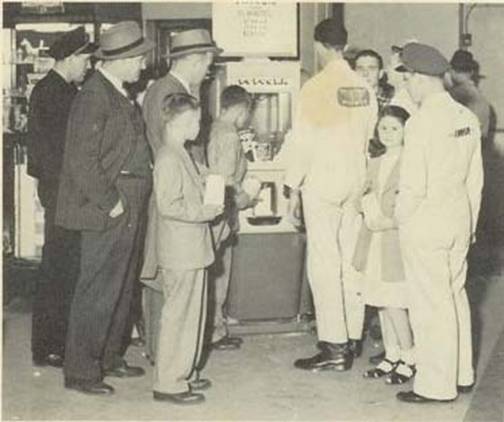
MANUFACTURERS:
U.S. Patent 2,216,805 for the predecessor to the MINIT POP machine was
filed back in 1939, though the MINIT POP that we are more familiar with
probably debuted around 1948.
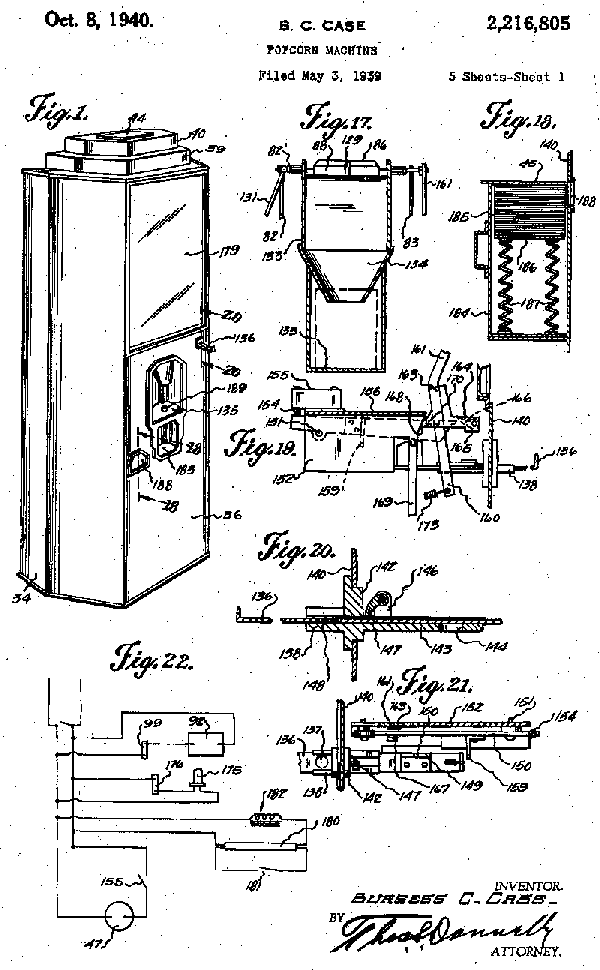
A more familiar looking cabinet style is seen in US Pat. Nos. 2,657,627 and 2,639,961, both filed in late 1947.
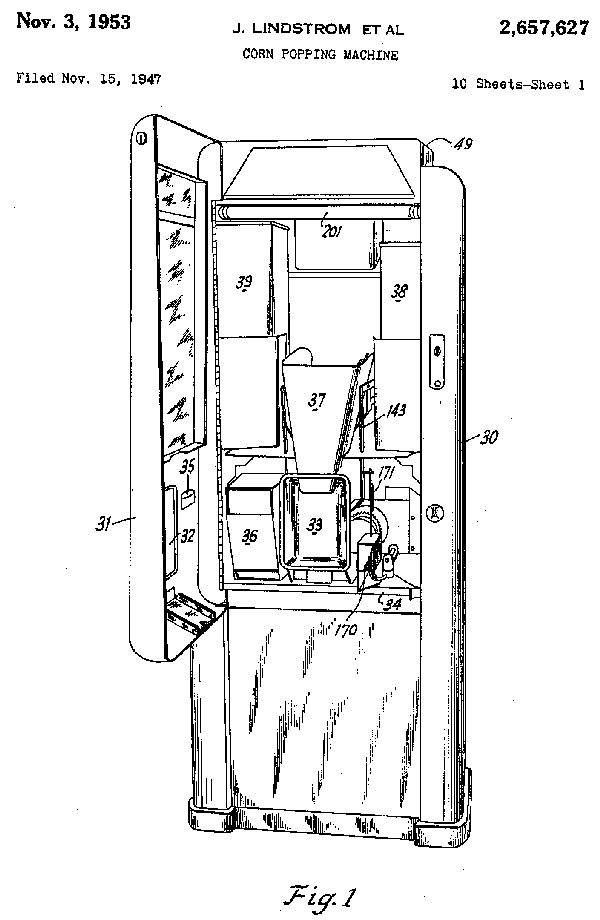
In late 1950, as explained in US Pat. No. 2,742,848, the design of the cooking element was changed from a STRAINER BASKET to a HOT PLATE design. As explained in that patent filing:
Where a bath of cooking oil is retained in the popping chamber between popping periods and maintained at or above the breakdown temperature, the breakdown of the oil is increased and an undesirable gum deposit is rapidly formed in the container defining the popping chamber, usually adjacent the liquid level therein. This gum deposit hardens and must be periodically cleaned by a special chemical cleaning operation. As the deposit builds up, the operating parts tend to bind against each other, hindering the mechanical operation, as well as leaving the machine in an unsightly unsanitary condition.
Truth be told, both cooking systems have their advantages and disadvantages. For instance, the strainer basket is unencumbered by electronics or oil supplies, so it can be somewhat frequently removed easily by taking out the 4 acorn bolts and dropped in the dishwasher. The patent confirms that the intent was easy removal for cleaning. This is not an option with the later hot plate basket, which includes heating elements, thermostats, and a hose connection to the oil supply. Thus, it must be cleaned in place.
According to the patents, the cycle time of the STRAINER BASKET design was 75 seconds (including 60 seconds for popping). The HOT PLATE design increased that time to 95 seconds. While this distinction is rather insubstantial, particularly for home use, the amount of oil absorbed by the corn is significantly different between the designs. According to the patents, the STRAINER BASKET design uses 3/4 ounce of oil per cycle, while the HOT PLATE design uses twice as much, 1 1/2 ounces of oil per cycle. That might be an important distinction for the calorie conscious.
Over the years, manufacturing rights for the popcorn machine passed through a number of companies. The first manufacturer, in 1948, was The Viking Tool & Machine Corp. of Belleville, NJ, who called the machine MINIT POP. Rights to manufacture the machine were apparently sold to a company in Minneapolis, MN in the late 1940s, who changed the name to U-POP-IT. Sometime after that, it appears to have been sold again to another company in Minneapolis, MN, who changed the name yet again to THE POPCORN SHOP. It appears that this wasn’t the end of the road for the popcorn machine design, as the author has seen a more modern styled cabinet probably from the late 1950s or early 1960s bearing the unmistakable mechanics of the U-POP-IT type apparatus, red popcorn supply cup and all, this time called POP-O-MATIC and manufactured by a company called VENDOTRONICS of Lynbrook, N.J. This late style machine packed much more functionality (e.g., salt packet dispenser, butter applicator, automatic bag dispenser) into a thinner cabinet, but most notably at the great expense of aesthetic appeal.

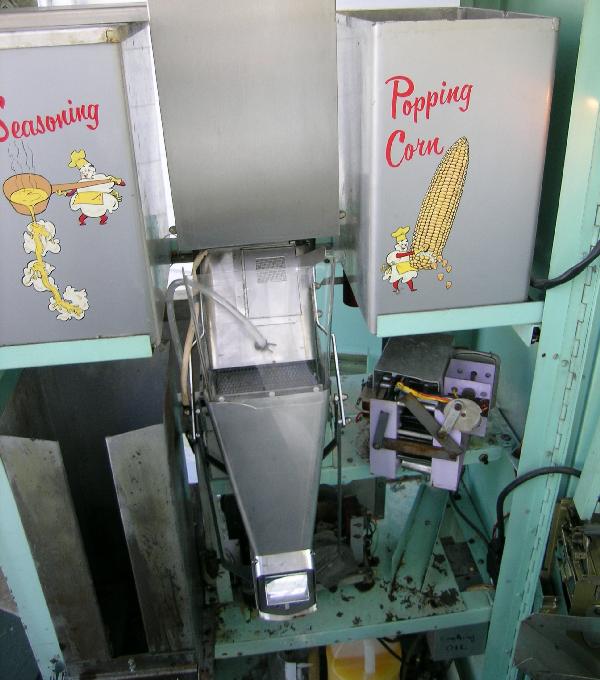
For all models except the late style POP-O-MATIC, the model name and manufacturer are printed on a metal name plate that’s riveted to the popcorn chute. Most name plates have a triangular shape to them, though U-POP-IT name plates appear to have had a period in which they were square.
COLORS:
Original color schemes varied. The most common original
color schemes that this author has seen on MINIT POP/U-POP-IT/THE POPCORN SHOP
style cabinets are GREEN machines with a YELLOW door or RED machines
with a CREAM door. Other color schemes are found as well, including
a deep BURGUNDY with SILVER door scheme, and a Pepsi BLUE with
hammered SILVER door (both of these being MINIT POPs).
Perhaps the most popular restoration color scheme is RED with a YELLOW door. Pinstriping, painted instructions on outside of cabinet, etc., are for the most part not original. However, much of what this author has seen in restored machines is quite pleasing, expressive of the particular restorer, and generally adds to the character and enjoyment of the machine today and beyond.
Original cabinet colors:
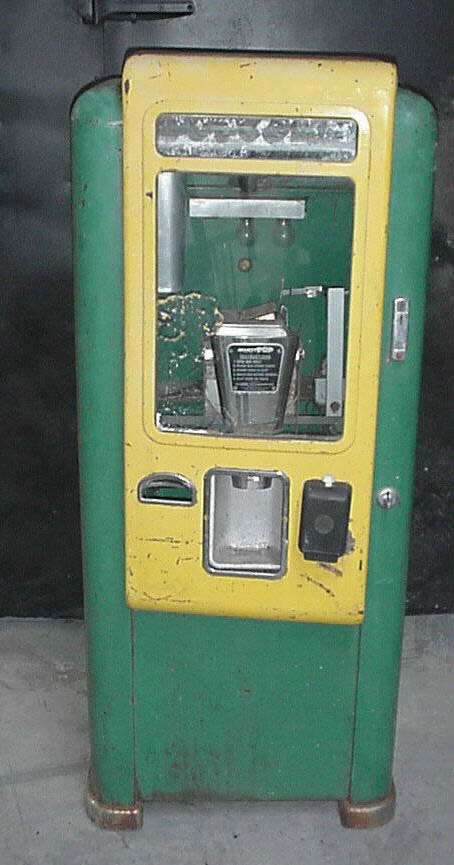
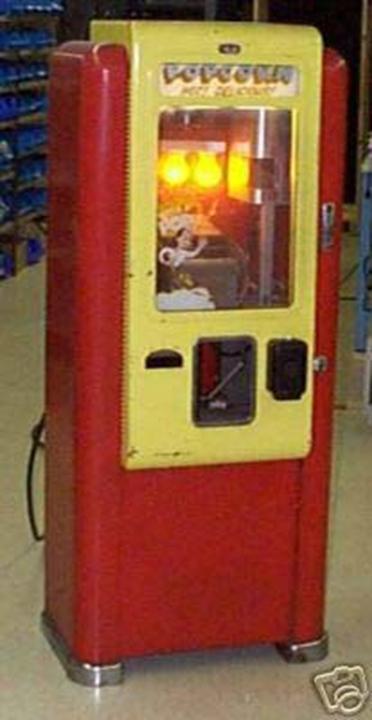
Cabinets restored to original colors:
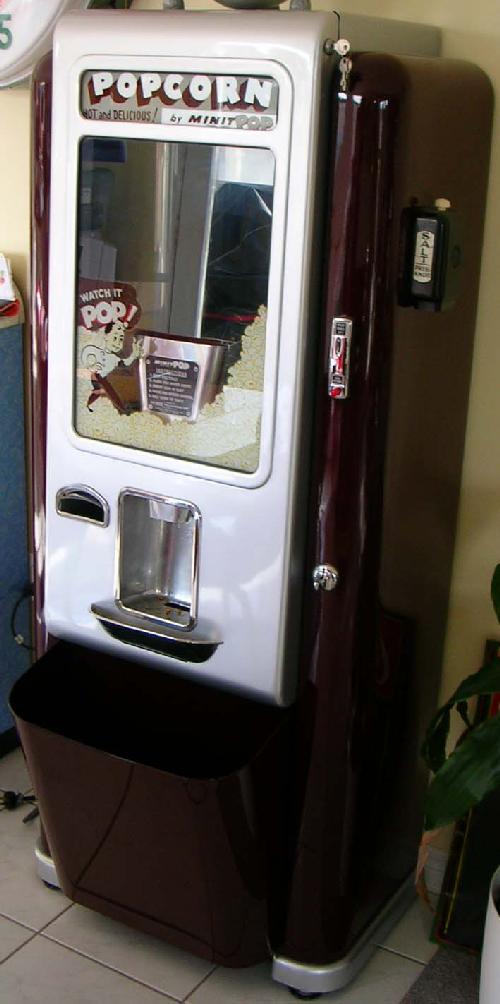
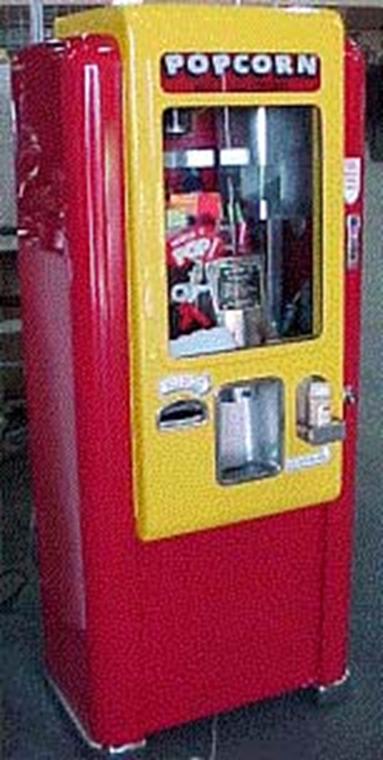
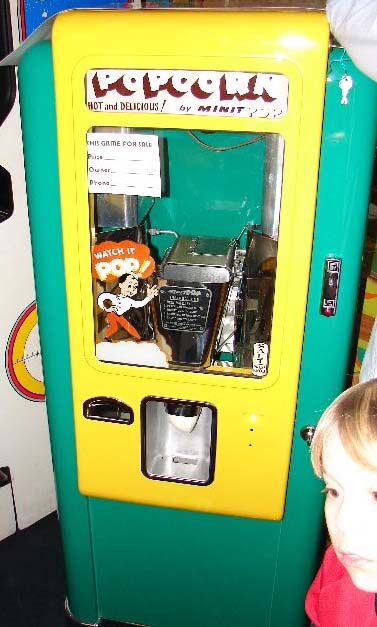
Internal views:
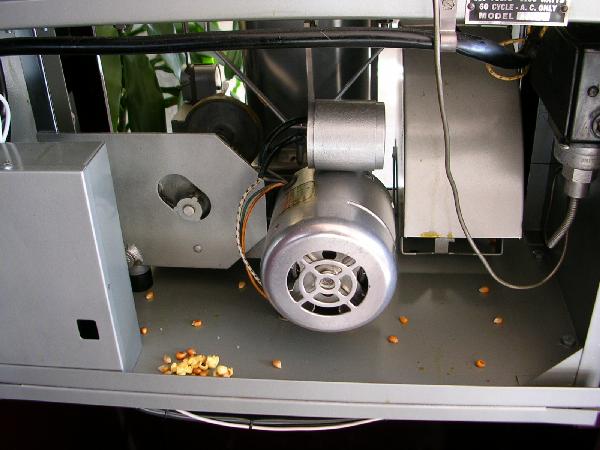
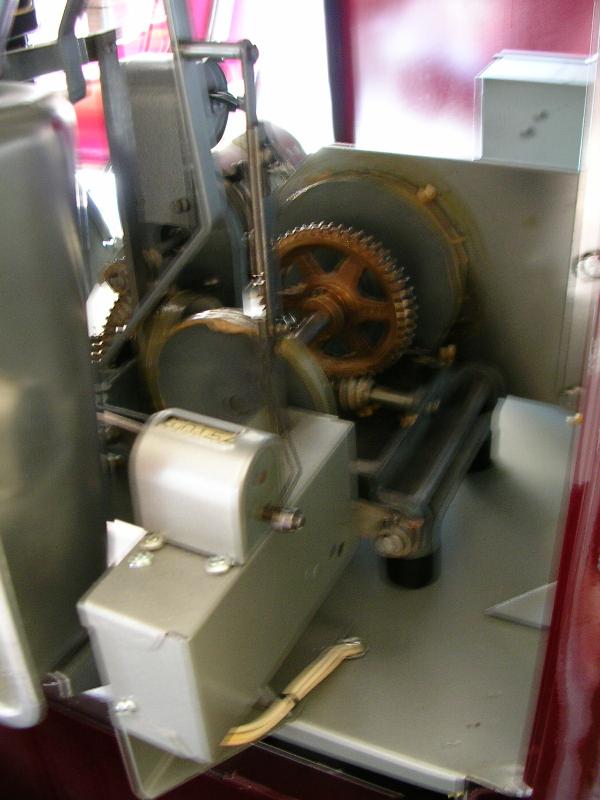
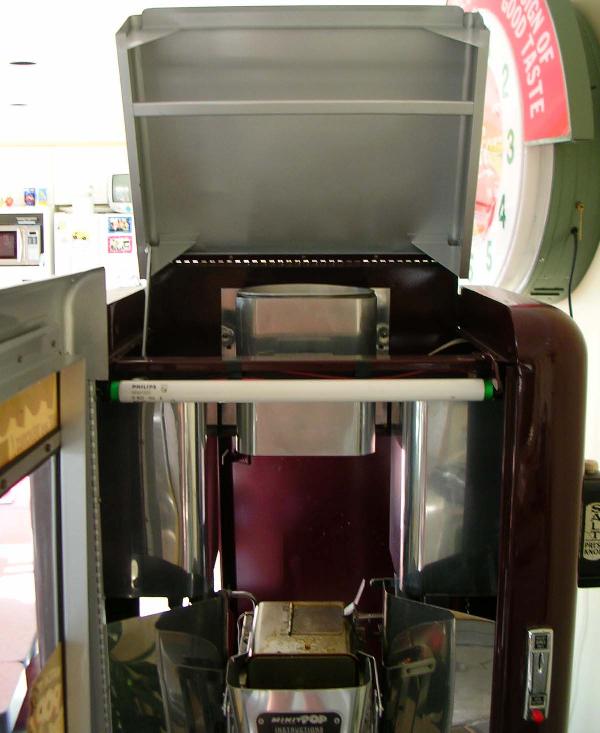
POPPING PLATFORM:
Perhaps the most significant change in the design over the
years was in the cooking system. The earliest cooking system
was an oil vat system, while later machines implemented an
aluminum hot plate system.
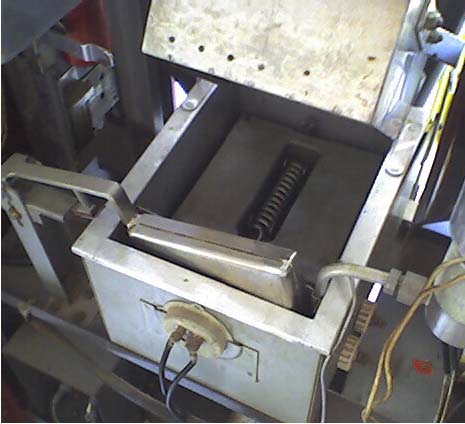
OIL VAT / STRAINER BASKET:
An oil vat and strainer basket
system is found generally in earlier machines,
mostly MINIT POP, though also seen in U-POP-ITs.
In the oil vat system, the popcorn strainer basket
has a screened bottom, and sits in about 3/16" of
popcorn cooking oil maintained at that level with a
float valve located in the oil reservoir. The oil
that the popcorn strainer basket rests in is maintained
at 395 degrees. In operation, corn kernels are poured
from the moving red kernel serving cup into the popcorn
strainer basket and shaken for 1 minute. At the end of
the cycle, the popcorn strainer basket is raised out of
the cooking oil, with any excess oil draining back to
the vat through the screen as the basket is raised.
The basket is tipped forward and popped corn is
delivered to the popcorn chute.
Basket Strainer:
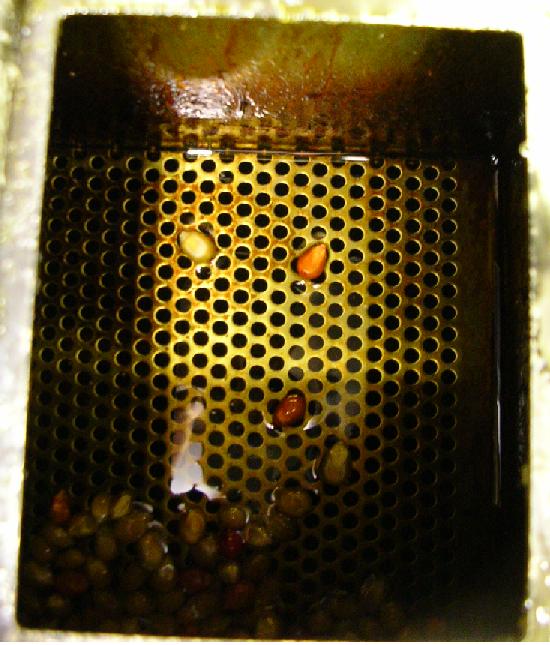
A wiring diagram for the STRAINER BASKET design is found in US Pat No 2,657,627, reproduced below:
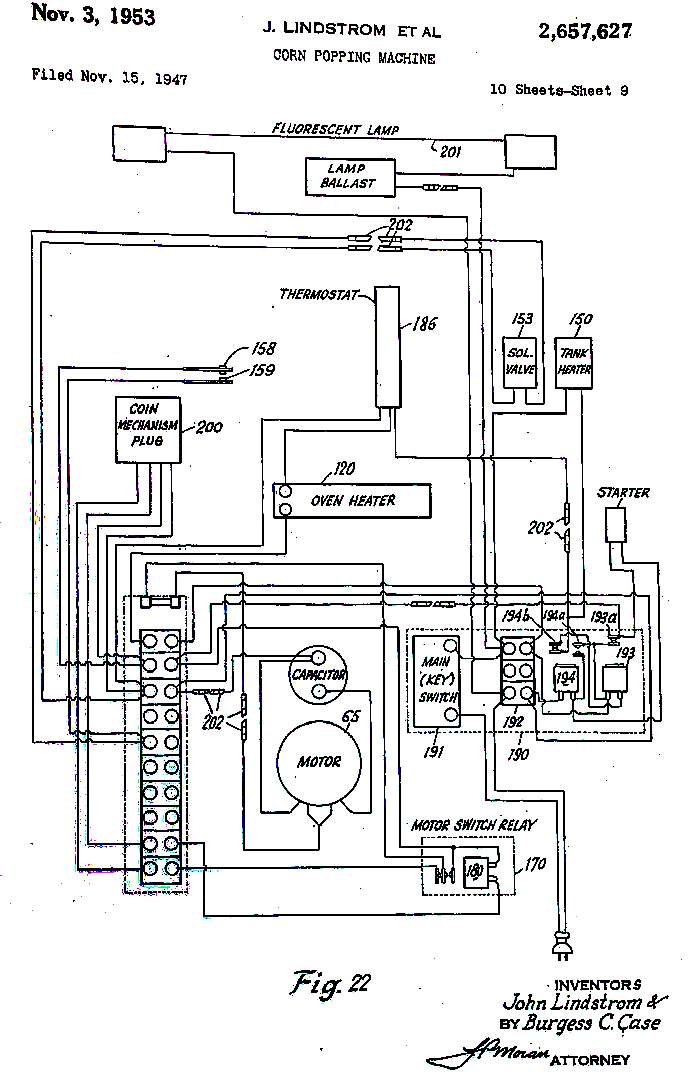
HOT PLATE:
An aluminum hot plate system is found generally
in later machines, like later U-POP-Its, THE POPCORN SHOPs,
and POP-O-MATICs. In the aluminum hot plate design, a hot
plate is mounted inside the popcorn cooking basket, which
in this version doesn’t have a screened bottom, but instead
has a solid hot plate mounted on the bottom. A squirt of
cooking oil is placed on top of the hot plate at the end
of a cycle, after the corn from that cycle has been
delivered to the customer’s bag. This squirt of oil is
maintained at 350 degrees until the next customer comes
along. Once a dime is inserted, more oil is placed on
the hot plate, and the corn kernels are poured on top
of the oil. The rest of the cooking cycle continues
just as it does for the oil vat type system. It is
presumed that all squirted oil is used up in the cooking
cycle as it is absorbed by the popcorn. At the end of
the cooking cycle, the popcorn cooking basket, hot plate
and all, is tipped forward, allowing all popped corn to
exit into the popcorn delivery chute. Adjustment of the
amount of oil squirted on the hot plate is made to ensure
that too much oil is not provided, which would make the
corn stick to the hot plate when tipped instead of being
delivered to the bag.
The hot plate design is a little more messy than the strainer basket design, though not if properly adjusted. In the hot plate system, any oil that isn’t absorbed by the popcorn pours into a catch basin below the basket, and drips down a waste pipe into an appropriate container. In the strainer basket design oil drains very quickly back through the screened bottom as the basket is lifted from the oil.
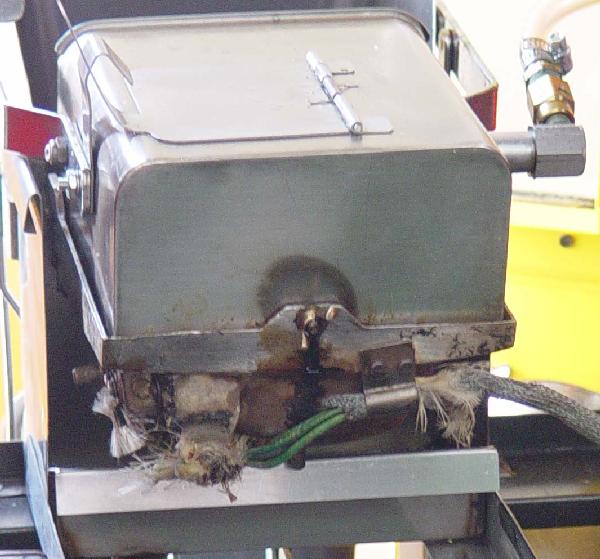
The 3/16" of oil in the OIL VAT variety machines is kept at the cooking temperature of 395 degrees while the machine is on, allowing the corn to pop in 1 minute. In the HOT PLATE variety machines, an initial squirt of oil is maintained on top of the hot plate at a standby 350 degrees, purportedly below the breakdown temperature of the cooking oil (at least with respect to coconut oil as used in the 1940s). This means that for most home collectors, you must turn the popcorn machine on about 20-30 minutes before you intend to use it to allow the cooking oil to reach the desired temperature.
Both systems work fine. The heating coil element for the oil vat system is relatively simple to restring and replace, and readily available from any good appliance supply store. The hot plate, on the other hand, is a custom item that has been reproduced, though it may become harder to find in the future.
One way to detect a hot plate system from the front of the machine (with the door open) is if you see an oil drain pipe pointing down at 45 degrees from the oil vat toward the right side as you look at the machine. From the back, the OIL VAT strainer system has a float valve just behind the cooking basket, whereas the hot plate has an electrical connection directly into the back of the cooking basket.
Note the oil drain pipe:
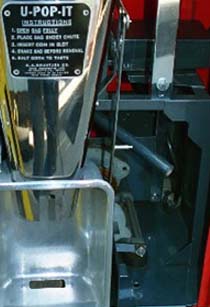
It has been said that hot plate machines are probably found equally as many as OIL VAT types, though there might be a slight favoritism to finding an OIL VAT type. It is believed that the HOT PLATE types might have had a higher rate of failure, leading to a higher percentage of discarded machines of that type. More likely though is that HOT PLATE machines were made for more years, and more recently, than were OIL VAT type machines.
Of note is that there is also an immersion heater in the oil supply vat to keep the oil supply at 100 degrees. Otherwise the coconut oil supply would congeal (unless you use straight Wesson oil, corn oil, or similar). But coconut oil gives the best taste and aroma (especially with the fan in the lid vent pushing the aroma out to passersby!)
The oil supply vat in all machines has a capacity of about 2 gallons. The oil supply vat should be kept at least 1/2 full of oil, which is about 1 gallon. If you have an oil vat cooking system with the popcorn strainer basket, the oil reservoir (which includes a float valve) has a capacity of about an additional 1 quart. One gallon of cooking oil will make about 200 bags of popcorn.
SALT BOX:
The Bakelite salt box is often missing from these machines
when found, but can be located with great perseverance
and patience. Early machines (i.e., MINIT POPs) tended
to have the salt box mounted on the side of the machine,
upper right or upper left, whereas later machines
(U-POP-ITs and THE POPCORN SHOPs) tended to have the salt
box mounted on the front of the machine, to the right of
the bag chute.
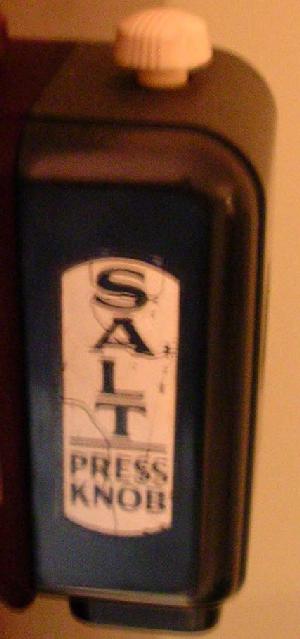
OTHER DIFFERENCES between models:
First of all, it should be said that MOST parts of the
popcorn machines are the SAME between the various models.
For instance, they all operated on a dime, even the
POP-O-MATIC (though that coin mechanism could give
15 cents change from a quarter) and at first glance by
the untrained eye look identical. Upon close inspection,
small differences can be found. While these differences
seem to start at various stages in the manufacturing
life of the machines, these changes are seen generally
in all models, most likely due to after-market modifications,
upgrades, etc. to the machine.
CLEAR WINDOW IN KERNEL VAT:
MINIT POPs appear for the most part to have had a solid
walled metal kernel supply vat (in cabinet, upper right
corner as you’re looking at the machine.) U-POP-ITs
and THE POPCORN SHOP machines had a small clear window
cut into the kernel supply vat, allowing the customer
to see the level of the corn supply. Interestingly,
the functional nature of the late model POP-O-MATIC seems
to have done away with the aesthetically pleasing window
in the kernel vat.
The clear window, in the opinion of this author, adds significantly to the interest of the interior during operation of the machine. If your MINIT POP does not have a window in the kernel vat, it can be cut rather easily with a dremel tool, and a clear plastic window riveted in, just as it was in later models of the machine.
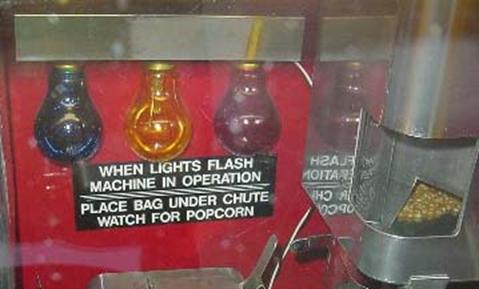
INTEGRATED GARGAGE CAN:
A garbage can was implemented in the bottom of the
cabinet of later models. The garbage can merely
hooks onto the cabinet shell when the front door
is opened, and is often removed or was never
originally with the machine. The US Patents in
1947 and 1950 to the cabinet interestingly do not
include the garbage can, giving rise to the thought
it was not an overly important part of the cabinet
design.
It is somewhat agreed by many collectors that the garbage can is not aesthetically pleasing to the design and physically gets in the way somewhat, so it is not a terribly missed component if not present. If your U-POP-IT does happen to include the garbage can, for ethical reasons you might want to keep it with the machine but not have it displayed. To this end, the author notes that apparently the garbage can be reversed so that it protrudes INSIDE the bottom of the cabinet.
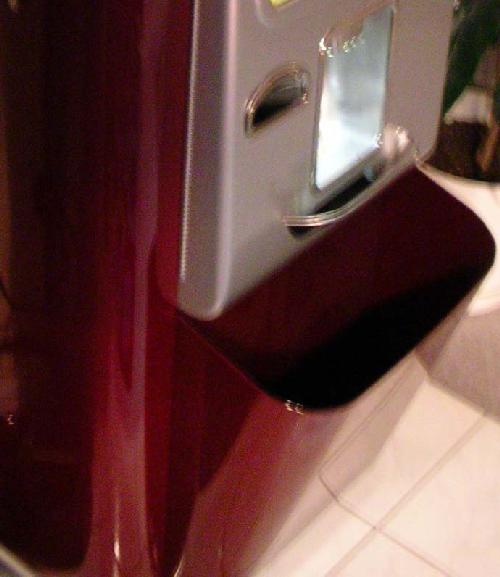
3-LIGHT FLASHING BAR:
The blue/yellow/green light bar appears to this
author to be original in many later machines
(e.g., during the U-POP-IT years, but an
after-market modification to early machines
if present. But again, it’s seen in the MINIT POP
models, though not as often. Many if not most
MINIT POPs don’t appear to have had the 3-light
bar originally (nor did the functional late model
POP-O-MATIC). Since this is such a popular feature
of the later machines, many early MINIT POP machines
are often retrofitted during the restoration
process to include a reproduction 3-light flashing bar.
From a restored machine, and from a brochure for THE POPCORN SHOP:
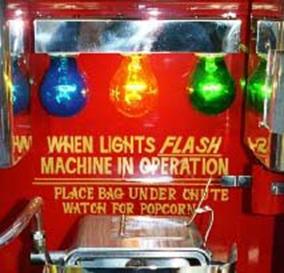
INSTRUCTIONS ON BACK DOOR:
It appears that the instructions on the back door,
often seen below the 3-light flashing bar, was a later
addition. Back door instructions are most often seen
in restored machines as a decal or hand-painted lettering,
stating:
WHEN LIGHTS FLASH
MACHINE IN OPERATION
------------------------
PLACE BAG UNDER CHUTE
WATCH FOR POPCORN.
Sometimes these instructions are lettered directly onto the back door, other times it’s seen as a plaque attached to the back door. One collector’s original machine included a white opaque marquee with instructions mounted over the 3-flashing light bar, covering the lights, but allowing the three different colors of the lights to indirectly fill the interior.
Many, if not most, MINIT POPs didn’t have instructions on the back door (or the 3-light flashing bar), making for a more bland appearance. Many collectors opt to add a reproduction 3-light flashing bar and instructions on the back door. While perhaps not original to that particular machine, the instructions add to the décor, and the flashing lights make for a tremendous upgrade to the interior.
OVERFLOW TRAY:
Stainless steel overflow trays seem to have been added to
the design sometime during the U-POP-IT era. This overflow
tray not only adds to the overall appearance of the popcorn
machine, but it probably adds even more to the functionality.
Any overflow kernels or popped corn that would otherwise fall
to the floor are caught by the overflow tray, which passes them
back inside the cabinet to a waiting catch box. While an original
catch box is not found in most, if not any, machines, it wouldn’t
be much more than a small garbage bin. Since it’s inside the
cabinet, it’ll never be seen by anyone other than the user when
cleaning out the machine, so just about any suitable garbage bin
can suffice.
Front and rear view of overflow tray:
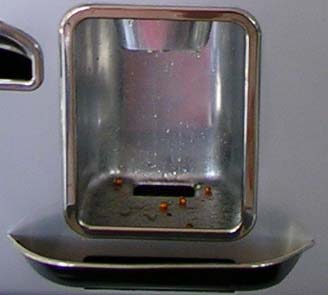
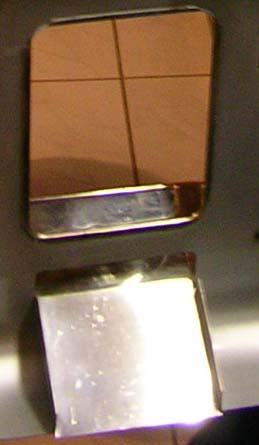
FRONT GLASS DECALS:
The MINIT POPs tended to have a large decal on the front.
This large decal appears to have been shrunk during the
MINIT POP phase, and eventually turned into just the
‘Watch It POP!” man standing on a single kernel starting
in the U-POP-IT phase and going through the THE POPCORN SHOP
phase. At least two original decals have been seen by the
author that matched the background color of the ‘Watch It POP!”
cloud above the man to the color of the cabinet. In those cases,
the background of the cloud was the same color blue as the blue
in a BLUE/SILVER schemed cabinet, and the same color burgundy
as in a BURGUNDY/SILVER schemed cabinet.
An original, early decal, from a MINIT POP:
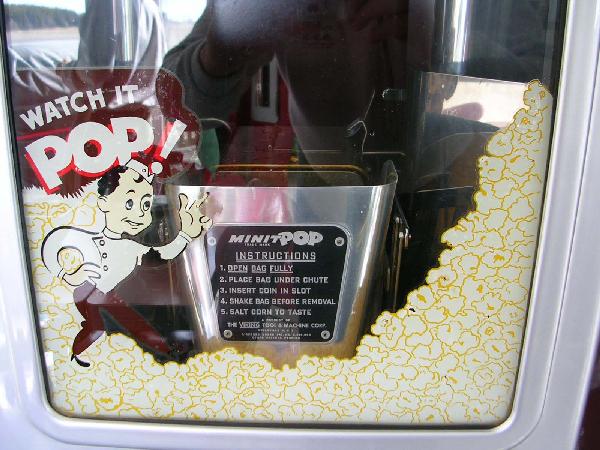
A reproduction MINIT POP decal, probably later than the one above, (on a restored U-POP-IT machine):
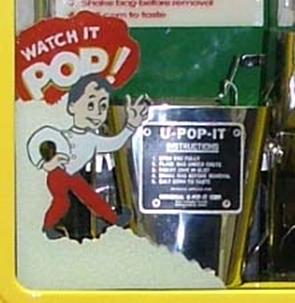
Decals were used heavily in the late style POP-O-MATIC:
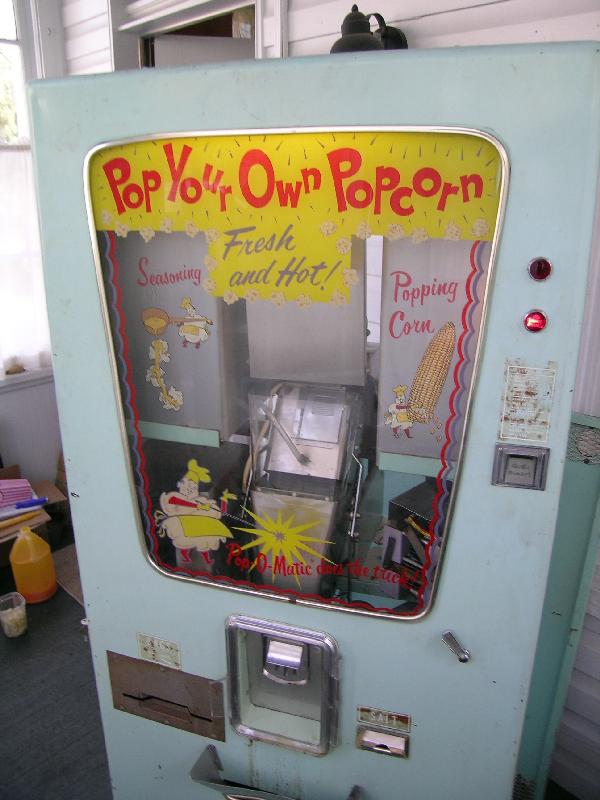
HEADER:
The earliest MinitPOP machines had no header at all, just
merely 3 white lights (instead of the fluorescent tube that’s
most often seen). These 3 white lights were ON all the
time-they didn’t flash. But generally speaking, the MinitPOP
machines had a white header that said “POPCORN Hot! Delicious!
By MinitPOP.” U-POP-IT machines had a red header that said
“POP your own CORN”. There are several other headers out
there, probably all based on original headers. Here are
some of the various headers encountered.
Early MINIT POP header:

The same header above, but lit up:

Minit Pops:



U-POP-IT headers:
Backside of header above:
EXHAUST FANs:
Many different types and designs of exhaust fans are seen in
the center top of the machine. Some are hidden from view,
others are hard to miss. Perhaps the least pleasing design
is in the latest model POP-O-MATIC machines where a fan is
installed dead center barely a few inches above the cooking
basket, and hidden from view with a huge flat stainless steel
panel.
Some MINIT POPs exhaust fans:
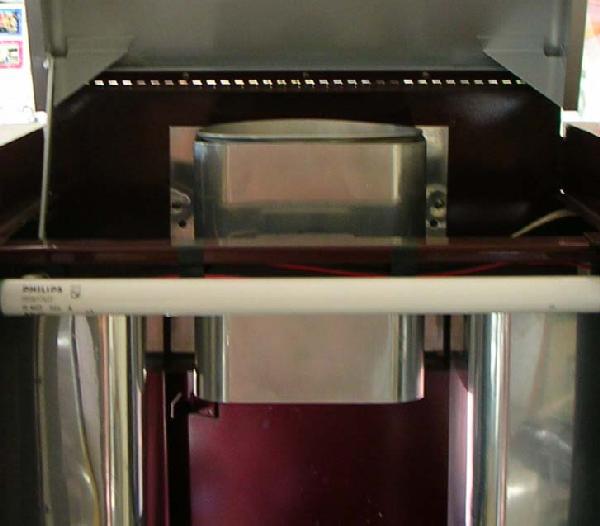
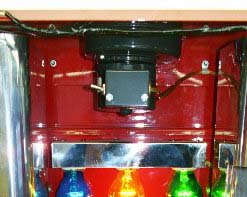
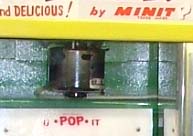
and the ever-functional POP-O-MATIC exhaust fan:
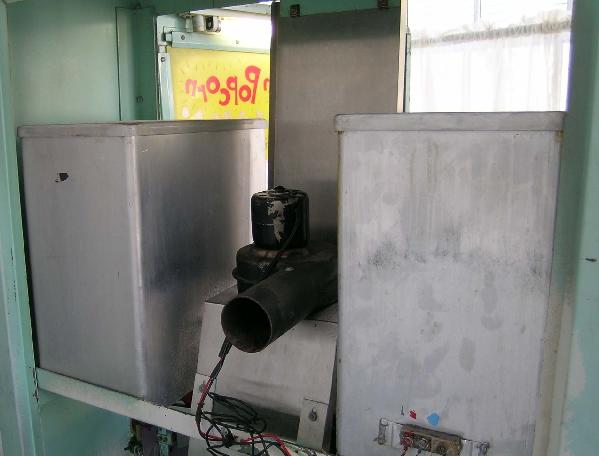
COOKING OIL:
Virtually any popcorn popping oil may be used. Originally 100% coconut
oil was used. Better yet is blended popcorn popping oil containing 76%
coconut oil together with other ingredients, including beta carradine
to add a yellow color and slight butter flavor to the popped corn.
This gives the popped corn great color, flavor and aroma. Generally
speaking, butter need not be added to the corn after it’s popped-only salt.
POPCORN BAGS:
The machine uses just about any 1 oz. popcorn bags
(about 2 1/2" wide x 8" tall), which are readily available
from popcorn supply sources. Interestingly, today’s popcorn
pops larger than back in the day. As a result, all things being
equal, the portion of corn that is popped will overflow the bag.
To adjust the amount of kernels supplied to the popcorn cooking
basket, you can adjust the bottom of the red delivery cup so
that it has a smaller volume. If that’s not enough to reduce
the amount of corn popped each cycle, then the slot in the
side can be increased toward the top, resulting in fewer
kernels in the delivery cup.
CLEANING:
The machines stay surprisingly quite clean. Once a month
or so it’s good to wipedown the popping basket to remove any
old kernels, inside the front glass, and the bag filling area.
Otherwise, the machines stay extremely clean, even after much use.
